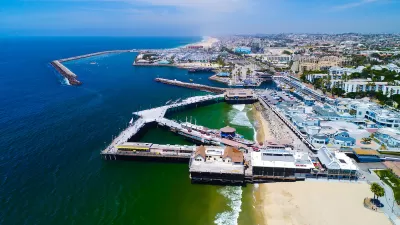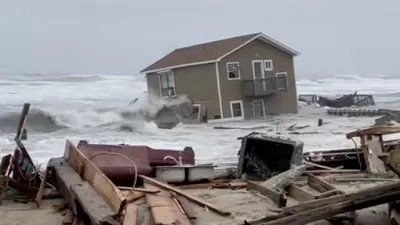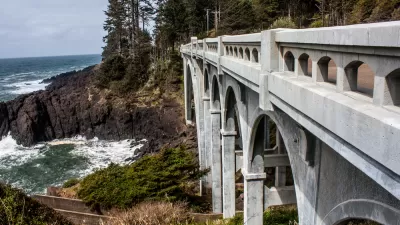In the wake of Hurricane Matthew, a researcher calls attention to the method behind the federal spending on billions of dollars of investment in unsustainable beaches.

Robert S. Young, a professor of coastal geology and director of the Program for the Study of Developed Shorelines at Western Carolina University, takes to the opinion pages of the New York Times to explain the ongoing "beach boondoggle" taking place on the East Coast.
The recent landfall of Hurricane Matthew provides a teachable moment for Young, who notes that the country is responding to the ongoing process of coastal erosion by "trying to hold every shoreline in place forever by pumping sand onto them, largely at federal expense." In fact, a named storm like Hurricane Matthew "can even turn locally funded beach 'nourishment' projects into federally funded ones."
Western Carolina has even created a beach nourishment viewer to illustrate the scale of beach nourishment projects since the early 1990s.
Young argues, however, that the federal funding of beach nourishment is folly. "As sea-level rise continues, and if storms intensify as predicted, the projects will require more sand, and more dollars," he writes. "We are going to run out of both."
While Young acknowledges the arguments in favor of beach nourishment (i.e., "It is true that beach and dune engineering projects benefit local communities. They can protect oceanfront homes and roads while providing a recreational beach for tourists to play on."), he also points out that those benefits are temporary and localized. Moreover, "numerous studies report that the primary beneficiaries of beach stabilization projects are oceanfront property owners."
FULL STORY: The Beach Boondoggle

Alabama: Trump Terminates Settlements for Black Communities Harmed By Raw Sewage
Trump deemed the landmark civil rights agreement “illegal DEI and environmental justice policy.”

Planetizen Federal Action Tracker
A weekly monitor of how Trump’s orders and actions are impacting planners and planning in America.

Why Should We Subsidize Public Transportation?
Many public transit agencies face financial stress due to rising costs, declining fare revenue, and declining subsidies. Transit advocates must provide a strong business case for increasing public transit funding.

Understanding Road Diets
An explainer from Momentum highlights the advantages of reducing vehicle lanes in favor of more bike, transit, and pedestrian infrastructure.

New California Law Regulates Warehouse Pollution
A new law tightens building and emissions regulations for large distribution warehouses to mitigate air pollution and traffic in surrounding communities.

Phoenix Announces Opening Date for Light Rail Extension
The South Central extension will connect South Phoenix to downtown and other major hubs starting on June 7.
Urban Design for Planners 1: Software Tools
This six-course series explores essential urban design concepts using open source software and equips planners with the tools they need to participate fully in the urban design process.
Planning for Universal Design
Learn the tools for implementing Universal Design in planning regulations.
Caltrans
Smith Gee Studio
Institute for Housing and Urban Development Studies (IHS)
City of Grandview
Harvard GSD Executive Education
Toledo-Lucas County Plan Commissions
Salt Lake City
NYU Wagner Graduate School of Public Service





























